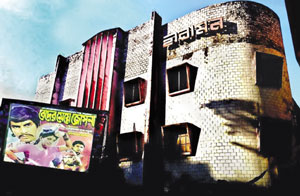
Video piracy rings death knell for Tk 10b film industry
Mohammad Mufazzal | Wednesday, 8 April 2015

The Tk 10 billion (1,000 crore) local film industry has come to such a pass that its very survival is now at stake due to multifarious problems including video piracy.
According to data available with the Bangladesh Cinema Hall Owners Association (BCHOA), out of 1,230 cinemas, more than 908 have wound up their business over the last one decade rendering around 28 thousand people jobless.
"Most of the films being produced in our industry are not proving hits commercially due to different reasons. This has left our survival at stake," said Nasir Uddin Dilu, convener of Bangladesh Film Producers and Distributors Association (BFPDA).
Other industry insiders blamed video piracy, inadequate technical hands, insufficient government support, use of smart phones and Internet and uncomfortable environment inside cinemas for ringing the death knell of the industry, once the only source of entertainment for the public.
The association said some other cinemas that managed to survive so long were no more in a position to carry on with the ever bulging losses.
The latest addition to the casualty list was the Heeramon cinema in Netrakona district that was closed just a week ago.
Film production has also taken a jolt from the prevailing situation. In the capital city seven film studios such as Popular, Bengal and Bari have been closed, said film producer Nuruzzaman Salam, who owns the production house Dilshad Kathachitra, while talking to the FE.
According to the BCHOA, the number of cinemas was 340 in the country before the Independence War in 1971.
Between 1971 and 1980 the number rose to 700. Between 1981 and 1990 the number rose to 920 and during 1991-2001 it reached as high as 1230 across the country.
Then started the rot. The number declined to 700 as of December 31, 2011.
Until the last Eid-ul-Azha the number of halls declined to 322 as the owners closed their business amid continuous losses.
"A section of viewers still go to cinema because of their love for Bangladeshi films. A producer cannot go for next production without recovering the cost of the previous production," said Mian Alauddin, general secretary of the BCHOA.
He stressed modernisation of cinema halls and production of films by applying time-befitting ideas and casting qualified artistes for bringing back the lost glory of the local tinsel-town.
Presently a significant number of producers are making films in the digital format instead of 35mm.
Jaaz Multimedia, which helped in digitalisation of 130 cinema halls produced 11 films in the digital format.
"Out of 11 films, nine could fetch profits after recovery of investments," said Abdul Aziz, chairman of the Jaaz Multimedia.
Nuruzzaman Salam, who runs two cinemas at Mohanganj Thana headquarters in Netrokona, said previously a film was released in around 120 halls at a time during any Eid festival.
"Now it's difficult to release a film in at least 25 halls. Once 1,500 viewers used to watch films a day in three halls in my locality. But the three halls now have been shut down as it is not possible even to realise the running cost," Mr. Salam said.
He said during the golden era of Bangla films, a section of people used to travel to Thana and district headquarters for marketing and return home after watching films.
"The electric fans, lights, projectors and foam seats then inside the cinemas were something new to the rural people. But now the things have changed. With the advent of mobile phones, Internet and satellite television channels it is difficult to keep someone seated in a hall for three hours, unless the film is a good one," Mr. Salam added.
In the capital city and divisional headquarters the cinema halls are being dismantled mainly for building multi-storied shopping complexes and the other cinemas are being replaced by community centres, storehouses and even hotels.
The number of cinemas has declined sharply in the capital and other metropolitan cities. According to BCHOA, there were 18 cinemas in the capital before Independence and the number rose to 44 in 2001.
But presently there are only 25 cinemas in the capital. In Chittagong the number of halls has come down to four from 18.
There were 21 cinemas in Jessore district including the famous Monihar Hall. Presently the number has come down to only six.
According to a survey conducted by the information ministry in 2011, the number of running cinemas was 774 in 2011 while 166 others ceased to exist.
And the average presence of viewers in the cinema halls then was 49,408 per day.
In the survey the information ministry expressed apprehension that 426 cinemas might cease to exist in near future. The film producers said most films released recently failed to return their investments prompting them to turn their back on film making.
According to the BFPDA, the number of released films also declined during the period of 2008 to 2013.
As per the data of BFPDA, in 2008 65 films were released whereas the number was 62 in 2009, 55 in 2010, 45 in 2011, 47 in 2012 and 44 in 2013.
"In 2014 a total of 74 films were released but most of those failed to fetch profits," said an official of the BFPDA.
Delwar Jahan Jhontu, president of Bangladesh Film Directors Association (BFDA), mainly blamed video piracy for the prevailing crisis faced by the Tk 10 billion film industry.
"Viewers need not go to halls as the films are available just after their release. This is the main reason behind the shutdown of cinemas," said the BFDA president.
He said the film industry would get back its glory if the government stops video piracy. The country's film industry started its journey with the first film 'Mukh and Mukhush' produced in 1956.
[email protected]